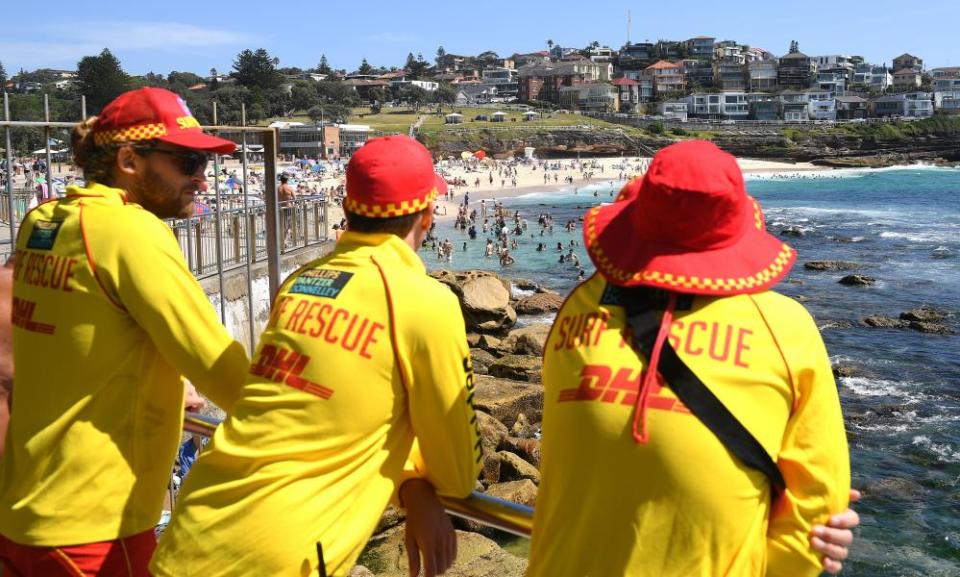Surf warning as drownings coincide with soaring temperatures across southeast Australia

Australians headed to the beach to escape a heatwave sweeping southeastern states have been warned to take care to avoid dangerous surf and not to try to rescue stricken friends alone, after three people died when they were swept off the rocks south of Sydney on Friday.
Five people have died while attempting to rescue another person since 1 December, according to Surf Lifesaving Australia – the same number that would usually die in a year.
Related: Port Kembla drownings: three dead after being swept into surf near Wollongong
The warning comes after another reminder of the dangers of ocean swimming, after a 58-year-old man was bitten by a shark while swimming near Lake Macquarie in NSW on Saturday evening. Bystanders managed to slow the bleeding and the man is in a serious but stable condition in hospital.
Shane Daw, the general manager of coastal safety at Surf Lifesaving Australia, said he would not tell parents not to attempt to rescue their children if they got into trouble in the water. But he urged people to take a second while running to help to call out, see if there was anyone else nearby who may be more experienced and able to assist, and also to see if there is anything that could help them stay afloat.
“As you’re running down, start yelling and call out for help,” he told the ABC. “Someone else may hear you and come to your aid.
“But have that split second, have a look around – is there an esky lid? Is there a boogie board? A floatation device that you can take with you? Because that will increase your chance of survival and also for the person that you’re going to assist.”
Temperatures in parts of South Australia were forecast to reach in the mid 40s on Sunday, as the heat wave moved east. Port Augusta was forecast to reach 45C, while Adelaide was predicted to hit 41C.
There is an extreme fire danger rating in place for the Mount Lofty Ranges and Adelaide Hills, and severe fire danger for the Yorke Peninsula, mid north, and lower south-east districts.
Tom Boweck, a senior forecaster with the Bureau of Meteorology (BoM) in Adelaide, said the high temperatures will not break the heat records set in recent very hot summers.
“Whilst they are very hot temperatures, we are not forecasting any record temperatures,” Boweck told Guardian Australia.
South Australia’s heat was expected to break late on Sunday, with a wind change to the south and south-west bringing cooler temperatures and humid conditions on Monday.
Temperatures in the northern parts of Victoria were tipped to climb above 40C on Sunday. Melbourne was forecast to peak at 35C in the mid-afternoon.
It was expected to remain hot overnight, with Melbourne forecast to have a minimum temperature of 25C, possibly rising as high as 27C, overnight before reaching 40C on Monday. Mildura, which was predicted reach 44C on Monday, would not drop below 28C on Sunday night, according to the forecast.
“It is not breaking records but it’s still quite warm,” duty forecaster from Melbourne, Jun Chen, said. “The last time we had above 25C minimum temperature was in 2018.”
The cool change was expected to reach southwestern Victoria late on Monday morning and Melbourne early in the evening. Eastern parts of the state, including the northeast and eastern Gippsland, were not forecast not get relief until Tuesday morning, with another warm night on Tuesday.
Related: Australia's record spring heat one-in-500,000 without climate change: analysis
In NSW, the temperatures were expected to peak in the southern half of the state on Tuesday and Wednesday. Sydney, which was forecast to reach 33C on Sunday, was not due to not cool off until Thursday. Western Sydney was expected to reach temperatures of 40C on Tuesday, while eastern parts of the city were likely to again peak at 33C.
The risk, said meteorologist Helen Kirkup, would be in the warm overnight temperatures in inland NSW.
“Between the hot days you don’t get to recover, houses don’t get to recover from the heat that has built up from the day, livestock does not get to recover,” she said.
While NSW was also not expecting record high temperatures, Kirkup said there was a risk people would be less used to the heat this year because it had been a mild summer.
“Last summer was obviously very hot,” she said. “There have not been many of these high temperatures so far this year, so when it does occur, it can have a bit more of an impact.”

 Yahoo Finance
Yahoo Finance 